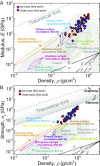Lightweight, flaw-tolerant, and ultrastrong nanoarchitected carbon
- PMID: 30886098
- PMCID: PMC6452738
- DOI: 10.1073/pnas.1817309116
Lightweight, flaw-tolerant, and ultrastrong nanoarchitected carbon
Abstract
It has been a long-standing challenge in modern material design to create low-density, lightweight materials that are simultaneously robust against defects and can withstand extreme thermomechanical environments, as these properties are often mutually exclusive: The lower the density, the weaker and more fragile the material. Here, we develop a process to create nanoarchitected carbon that can attain specific strength (strength-to-density ratio) up to one to three orders of magnitude above that of existing micro- and nanoarchitected materials. We use two-photon lithography followed by pyrolysis in a vacuum at 900 °C to fabricate pyrolytic carbon in two topologies, octet- and iso-truss, with unit-cell dimensions of ∼2 μm, beam diameters between 261 nm and 679 nm, and densities of 0.24 to 1.0 g/cm3 Experiments and simulations demonstrate that for densities higher than 0.95 g/cm3 the nanolattices become insensitive to fabrication-induced defects, allowing them to attain nearly theoretical strength of the constituent material. The combination of high specific strength, low density, and extensive deformability before failure lends such nanoarchitected carbon to being a particularly promising candidate for applications under harsh thermomechanical environments.
Keywords: iso-truss; nanolattices; octet-truss; pyrolytic carbon; specific strength.
Copyright © 2019 the Author(s). Published by PNAS.
Conflict of interest statement
The authors declare no conflict of interest.
Figures





References
-
- Gibson LJ, Ashby MF. Cellular Solids: Structure and Properties. 2nd Ed Cambridge Univ Press; Cambridge, UK: 1999.
-
- Hamm CE, et al. Architecture and material properties of diatom shells provide effective mechanical protection. Nature. 2003;421:841–843. - PubMed
-
- Weiner S, Wagner HD. The material bone: Structure-mechanical function relations. Annu Rev Mater Sci. 1998;28:271–298.
-
- Wegst UGK, Bai H, Saiz E, Tomsia AP, Ritchie RO. Bioinspired structural materials. Nat Mater. 2015;14:23–36. - PubMed
Publication types
LinkOut - more resources
Full Text Sources
Other Literature Sources

